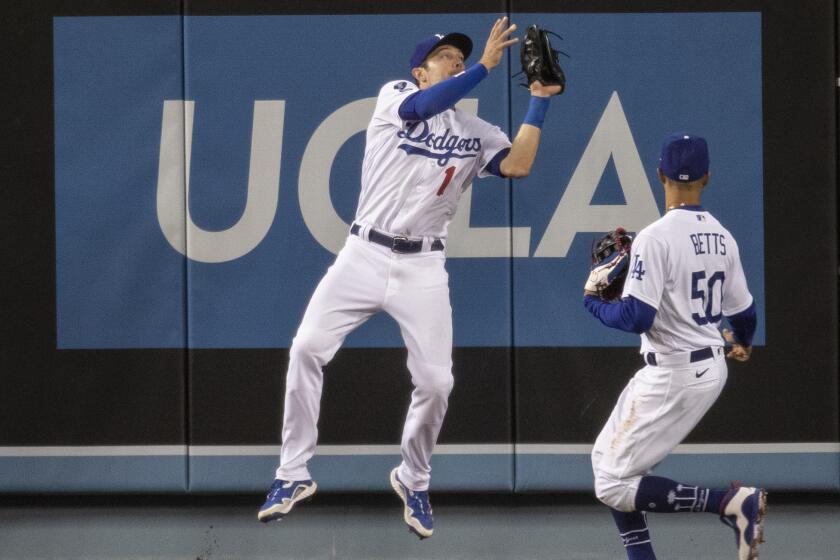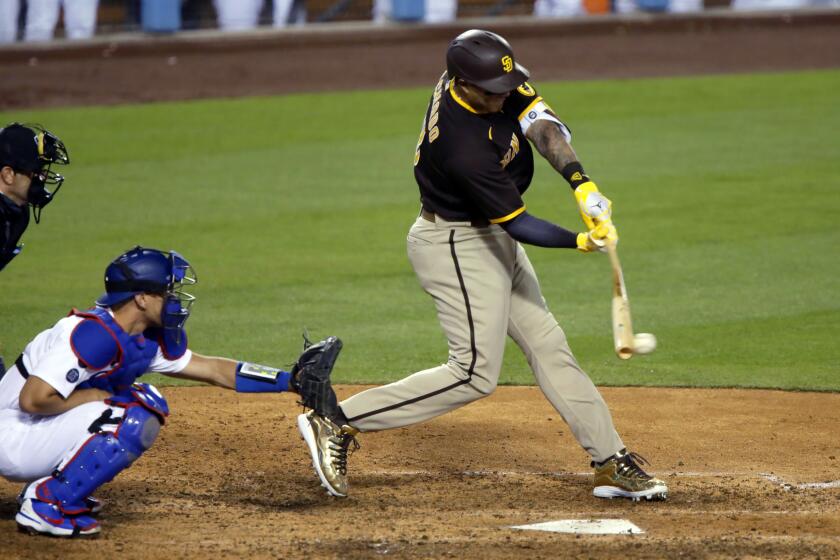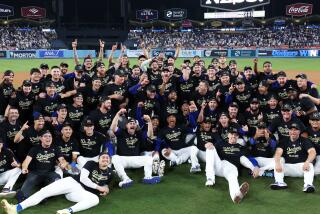For now, the Padres are a lot more in the running than the Dodgers

- Share via
The Dodgers don’t play the San Diego Padres again until June 21, giving the defending World Series champions almost two months to figure out how to neutralize the one glaring advantage their National League West rivals have over them: the running game.
Little separated the Dodgers and Padres during an 11-day stretch in which they played seven hotly contested games, packing enough dramatic twists and turns and momentum-shifting hits and plays to fill a postseason series or three.
When the combatants were sent to their neutral corners after San Diego’s stunning 8-7, 11-inning come-from-behind win in Chavez Ravine on Sunday night, the Padres held a 4-3 edge in the series, having outscored the Dodgers 32-30.
In the 68 innings played, the teams were within two runs of each other in 62 innings, within one run of each other in 49 innings and tied after 21 innings.
Both rotations were superb. Both bullpens got some lockdown work from back-end relievers while absorbing body blows in the middle. Both offenses packed a punch, with some occasional failures in the clutch.
But one number jumped off the stat sheet like a ball off the bat of Padres shortstop Fernando Tatis Jr., who slugged five homers in four games in Dodger Stadium: The Padres stole 18 bases in the seven games and were caught stealing once, when Dodgers left-hander Clayton Kershaw picked off Wil Myers at first base Friday night.
The Dodgers and Padres have played 39 innings of riveting baseball this season and have been separated by two runs or fewer in 36 of those innings.
“That’s one of the things you can always get better at as a ballclub,” manager Dave Roberts said before Monday night’s 5-3, 10-inning loss to the Cincinnati Reds in Dodger Stadium. “On the pitching side in particular, varying looks, times to the plate, throwing over … we need to get better with that.”
Four weeks into the season, no team has been easier to run on than the Dodgers, who have allowed 28 stolen bases and caught five runners attempting to steal. No other team had allowed more than 15 stolen bases.
Even the slug-and-chug Reds, who entered Monday with a major league low of two stolen bases, doubled that total Monday night when Alex Blandino stole third in the seventh inning and Nick Castellanos stole second in the 10th.
Catcher Will Smith has allowed 16 stolen bases and caught three runners stealing in 129 2/3 innings behind the plate, and Austin Barnes has allowed 12 stolen bases and caught two runners in 80 2/3 innings.
Dodgers pitcher Dustin May was dominant over six innings. Then a parade of relievers took the mound and erased all that.
The Padres, not surprisingly, are the most aggressive baserunning team in baseball, their major league-leading 32 stolen bases 10 more than the Kansas City Royals, who ranked second with 22 entering Monday. San Diego swiped five bases against the Dodgers in each weekend game.
“If you look at what they did offensively, that was part of their plan, to be aggressive on the bases,” Roberts said. “They have some athleticism on their club, and they exploited us. We need to get better and learn from it, and we will.”
The failure to control the running game falls more on the pitchers than the catchers, the decisive 11th inning of Sunday night’s game providing an example.
With two on and no outs, Dodgers left-hander Garrett Cleavinger, who was making his second big league appearance, paid little attention to Tatis at second. The reliever did not step off the rubber or make any pick-off attempts. On the first two pitches to Manny Machado, Cleavinger didn’t even look twice at Tatis.

Tatis got a great jump, taking off before Cleavinger lifted his front leg to start his delivery, to trigger a double steal, with Trent Grisham swiping second. Machado popped out to third, but Eric Hosmer sent a sacrifice fly to center to score the eventual winning run.
“If you look at the first couple of weeks, teams are taking advantage and running more on our guys, getting guys in motion,” Roberts said. “We know Tatis runs. We just have to be better at varying looks, picking, inside moves.”
Through Sunday, Dodgers starters combined to allow 10 stolen bases in 14 attempts. Relievers combined to allow 18 stolen bases in 19 attempts, with closer Kenley Jansen, who is notoriously poor at holding runners, yielding six stolen bases in six attempts and setup man Blake Treinen giving up three in four attempts.
An inability to control the running game won’t hurt the Dodgers against most clubs. With such an emphasis on launch angle and power over the last decade, stolen bases dropped from 3,229 in 2012 to 2,280 in 2019, the last full season before the pandemic.
Are you a true-blue fan?
Get our Dodgers Dugout newsletter for insights, news and much more.
You may occasionally receive promotional content from the Los Angeles Times.
But the Padres have five players — Machado, Grisham, Tatis, Myers and Jurickson Profar — who already have at least four stolen bases through 24 games.
And with teams playing 12 more regular-season games, which could determine who wins the division and who is forced to play a win-or-go-home, one-game wild card playoff, and a possible postseason series looming between the two, San Diego’s speed on the basepaths could make a huge difference.
More to Read
Are you a true-blue fan?
Get our Dodgers Dugout newsletter for insights, news and much more.
You may occasionally receive promotional content from the Los Angeles Times.











